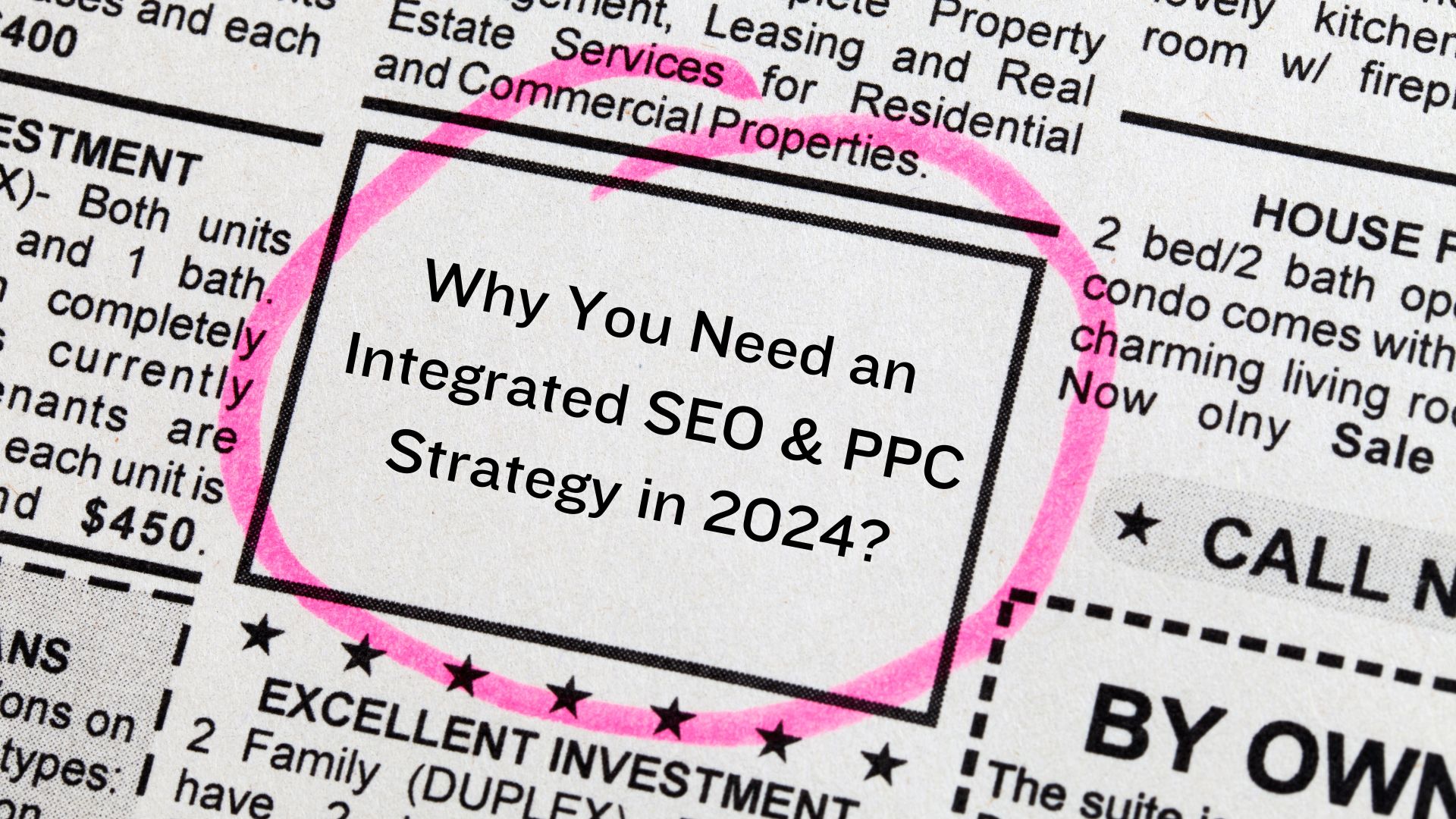What if there was a way to combine the power of organic search ranking with the targeted reach of paid advertising? Enter the integrated SEO & PPC strategy – your secret weapon for dominating your competition in 2024.
Why You Need an Integrated SEO & PPC Strategy in 2024
Here’s the reality: relying solely on SEO or PPC can limit your online reach. SEO takes time and consistent effort to build organic ranking, while PPC can be expensive if not strategically managed. But by integrating these two marketing channels, you create a powerful synergy that delivers exceptional results.
Here are just a few reasons why an integrated SEO & PPC strategy is crucial for success in 2024:
Increased Visibility & Reach: SEO helps you rank organically for relevant keywords, putting your brand in front of potential customers actively searching for solutions. PPC allows you to target specific audiences with laser focus, ensuring your message reaches the right people at the right time. This combined approach expands your reach significantly.
Enhanced Brand Awareness: Consistent messaging across SEO and PPC campaigns reinforces your brand identity and builds trust with potential customers. When they see your brand appearing organically in search results and through targeted ads, it creates a sense of familiarity and credibility.
Targeted Traffic & Conversions: Imagine attracting users who are already actively searching for what you offer (thanks to SEO) and then amplifying that by targeting users with high purchase intent through PPC. This targeted approach leads to more qualified leads and ultimately, higher conversions.
Data-Driven Optimization: Both SEO and PPC campaigns generate valuable data. You can leverage this data to refine your overall strategy. Identify high-performing keywords, landing pages, and audience segments to optimize your approach for maximum impact.
Staying Ahead of the Curve: The digital marketing landscape is constantly evolving. With an integrated strategy, you can adapt to the latest trends in SEO (like voice search optimization) and PPC (like AI-powered audience targeting). This ensures you stay competitive and reach your target audience effectively.
Demystifying SEO & PPC: What You Need to Know
Before diving into the nitty-gritty of building an integrated strategy, let’s get a clear understanding of SEO and PPC.
Search Engine Optimization (SEO): SEO is the process of optimizing your website and its content to improve its organic ranking in search engine results pages (SERPs) for relevant keywords. In simpler terms, it’s about making your website more attractive and relevant to search engines, so when people search for terms related to your business, your website shows up higher in the results.
Here are some key SEO factors to consider in 2024:
On-page Optimization: This involves optimizing your website content (titles, meta descriptions, headings, images) with relevant keywords and ensuring a positive user experience (mobile-friendliness, fast loading speed). Focus on creating high-quality content that provides value to your audience.
Off-page Optimization: This involves building high-quality backlinks to your website from other reputable sites. Backlinks act like votes of confidence for your website, signaling to search engines that your content is valuable and trustworthy.
Technical SEO: This refers to the technical aspects of your website that can impact SEO performance, such as website structure, schema markup, and crawlability. While technical SEO might sound complex, ensuring your website is user-friendly and easily accessible to search engines is crucial.
Pay-Per-Click (PPC) Advertising: PPC advertising is a form of online advertising where you pay a fee each time someone clicks on your ad. Popular PPC platforms include Google Ads, Microsoft Advertising, and social media advertising platforms like Facebook Ads and Instagram Ads. With PPC, you can target specific keywords, demographics, interests, and behaviors to reach your ideal audience.
Here are some key considerations for PPC success in 2024:
Keyword Research & Targeting: Identifying the right keywords is essential for effective PPC campaigns. Look for relevant keywords with high search volume and low competition. Utilize different keyword match types (broad, phrase, exact) to target your audience strategically.
Ad Creation & Landing Pages: Compelling ad copy is key to grabbing attention and driving clicks. Craft clear, concise ads that highlight your unique selling proposition (USP) and include a strong call to action (CTA). Don’t forget about landing pages – these are the web pages users arrive at after clicking on your ad. Ensure your landing pages are optimized for conversions with a clear value
Crafting Your Integrated SEO & PPC Masterpiece
Now that you understand the power of an integrated SEO & PPC strategy and the fundamentals of SEO and PPC, let’s get down to business and build your winning campaign!
Planning & Research: Laying the Foundation
A successful integrated strategy starts with a solid foundation. Here’s what you need to do in the planning and research phase:
Know Your Audience: Before you start crafting content or designing ads, take time to understand your target audience. Who are you trying to reach? What are their needs, challenges, and pain points? Defining your ideal customer persona will guide your entire strategy.
Keyword Research is King (and Queen): Conduct thorough keyword research to identify relevant keywords for both SEO and PPC campaigns. Tools like Google Keyword Planner and SEMrush can help you uncover high-volume, low-competition keywords that your target audience is actively searching for.
Analyze the Competition (But Don’t Copy): Take a peek at what your competitors are doing in the SEO and PPC space. Analyze their keyword usage, ad copy, and landing pages. However, remember, the goal is to be inspired, not to copy!
Set SMART Goals: Define clear and measurable objectives for your integrated campaign. Do you want to increase website traffic by 20%? Generate 100 qualified leads per month? Setting Specific, Measurable, Achievable, Relevant, and Time-bound (SMART) goals will help you track progress and measure success.
Budgeting for Success: Allocate your marketing budget between SEO and PPC based on your goals and resources. Generally, SEO requires a more long-term investment, while PPC offers faster results but comes with ongoing costs per click.
SEO Implementation: Building a Strong Organic Foundation
Now that you have a plan, let’s focus on building a strong foundation for organic traffic through SEO:
On-page Optimization:
Keyword Integration: Optimize your website content (titles, meta descriptions, headings, and body text) with your target keywords. However, avoid keyword stuffing – focus on creating natural, informative content.
Content is King: Create high-quality, valuable content that engages your audience and addresses their search intent. This could include blog posts, articles, infographics, videos, and more.
Mobile-First: Ensure your website is mobile-friendly and offers a positive user experience on all devices. In 2024, a significant portion of searches happen on mobile phones, so prioritize a seamless mobile experience.
Technical SEO: While technical SEO might seem daunting, it’s crucial. Ensure your website is crawlable and indexable by search engines. Tools like Google Search Console can help identify and fix technical SEO issues.
Off-page Optimization: Build high-quality backlinks to your website from other reputable sites. Backlinks act as votes of confidence for your website, influencing search engine ranking. Here are a few ways to earn backlinks:
Guest Blogging: Contribute guest articles to relevant websites in your industry. Broken Link Building: Find broken links on relevant websites and offer your content as a replacement.
Create Link-worthy Content: Create valuable, shareable content that naturally attracts backlinks from other websites.
PPC Implementation: Targeted Advertising for Maximum Impact
Now let’s leverage the power of PPC to reach your target audience with laser focus:
Campaign Setup & Targeting: Choose the Right Platform: Select the PPC platform that best suits your target audience and industry. Google Ads remains a dominant player, but social media advertising platforms like Facebook Ads can be highly effective depending on your target demographic.
Keyword Targeting: Utilize your keyword research to create targeted keyword groups and ad groups for your PPC campaigns.
Audience Targeting: Go beyond keywords! Leverage audience targeting options like demographics, interests, behavior, and location to reach the right people at the right time.
Ad Extensions for Enhanced Performance: Utilize ad extensions like phone numbers, location callouts, and sitelink extensions to improve your ad’s visibility and encourage user interaction.
Content & Landing Pages: The message you convey in your ads and landing pages is crucial for conversions:
Compelling Ad Copy: Craft clear, concise ad copy that highlights your unique selling proposition (USP) and includes a strong call to action (CTA).
Targeted Landing Pages: Design targeted landing pages for each PPC campaign that are relevant to the ad copy and offer a clear call to action (CTA). Ensure landing pages are optimized for conversions with a clear value proposition, strong visuals, and easy-to-use forms. Don’t send users on a wild goose chase after clicking your ad – make the conversion process smooth and seamless.
Data Analysis & Optimization: The Never-Ending Cycle of Improvement
Your integrated SEO & PPC strategy is not a set-it-and-forget-it approach. Continuously monitor and analyze data to optimize your campaigns for maximum impact:
Track Key Metrics: Regularly monitor the performance of your SEO and PPC campaigns using analytics tools like Google Search Console and Google Ads reporting. Key metrics to track include website traffic, impressions, clicks, conversions, and cost-per-acquisition (CPA).
Analyze Keyword Performance: Identify high-performing and underperforming keywords for both SEO and PPC. Consider increasing your bids for high-performing PPC keywords and revisit your SEO strategy for underperforming organic keywords.
A/B Testing is Your Friend: Don’t be afraid to experiment! A/B test different ad variations, landing pages, and SEO elements to identify the most effective combinations. Test different headlines, CTAs, and landing page layouts to see what resonates best with your audience.
Embrace Automation: In 2024, leverage the power of automation! Tools can help streamline PPC campaign management and optimize bids for conversions. Utilize automated bidding strategies to free up your time and maximize campaign efficiency.
Data-Driven Decisions: Use the insights gleaned from data analysis to refine your overall strategy. Make data-driven decisions to improve both organic and paid reach, ultimately leading to higher conversions and a greater return on investment (ROI).
Advanced Techniques for 2024: Stay Ahead of the Curve
The digital marketing landscape is constantly evolving. Here are some advanced techniques to keep your integrated SEO & PPC strategy future-proof:
Leverage First-Party Data: Don’t underestimate the power of your own data! Utilize website visitor data, customer information, and email marketing lists to create more targeted PPC campaigns. Tailor your ads and landing pages to specific audience segments based on their past interactions with your brand.
Embrace Automation (Again!): As mentioned earlier, automation is key in 2024. Explore advanced automation tools for SEO tasks like content optimization and competitor analysis. This can free up your time to focus on strategic initiatives.
Voice Search Optimization: Voice search is becoming increasingly popular. Optimize your content and PPC campaigns for voice search queries. People tend to use longer, more conversational phrases when searching by voice. Focus on natural language and answer potential questions users might ask through voice assistants.
Social Commerce Integration: The lines between social media and online shopping are blurring. Combine your PPC advertising with social commerce platforms like Instagram Shopping to streamline the buying journey for users who discover your brand on social media.
Omnichannel Marketing: Create a cohesive brand experience across all marketing channels (SEO, PPC, social media, email marketing). Ensure your messaging is consistent and reinforces your brand identity across all touchpoints. This helps build trust and familiarity with potential customers, ultimately leading to conversions.
Conclusion: Dominate & Thrive in 2024
By implementing an integrated SEO & PPC strategy, you can achieve remarkable results in 2024. Remember, the key lies in ongoing monitoring, analysis, and adaptation. Continuously monitor your campaigns, embrace new trends, and leverage data insights to optimize your approach.








0 Comments